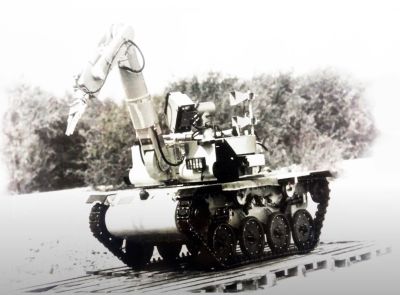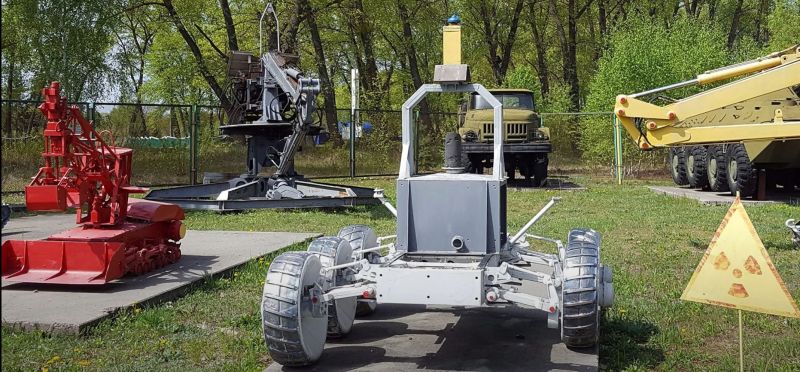Before the Chernobyl Nuclear Power Plant (ChNPP, spelled ‘Chornobyl’ in Ukrainian) disaster in 1986, there had been little need for radiation-resistant robots to venture into high-risk zones.

Yet in the aftermath of the massive steam explosion at the #4 reactor that ripped the building apart — and spread radioactive material across the USSR and Europe — such robots were badly needed to explore and provide clean-up services. The robots which were developed and deployed in a rush are the subject of a recent video by [The Chornobyl Family].
While some robots were more successful than others, with the MF-2 remote mine handling robot suffering electronic breakdowns, gradually the robots became more refined. As over the years the tasks shifted from disaster management to clean-up and management of the now entombed #4 reactor, so too did the robots. TR-4 and TR-5 were two of the later robots that were developed to take samples of material within the stricken reactor, with many more generations to follow.
The video also reveals the fate of many of these robots. Some are buried in a radioactive disposal site, others are found on the Pripyat terrain, whether set up as a tourist piece, or buried in shrubbery. What’s beyond doubt is that it are these robots that provided invaluable help and saved countless lives, thanks to the engineers behind them.

















Robodescendents are going to look upon this bit of history and wonder where all the humans went.
They all died of some weird bio-engineeried disease called ‘Big pox’.
I’m wondering how much real research is being done in this direction.
From what I remember of Fukushima, a lot of robots also failed there.
I’m thinking about a grounds up approach. What do high radiation levels do with materials? Metals seem to be all right, they do get contaminated, but don’t fail (quickly). But what about lubricant, hydraulic fluids, plastic materials from rubber wheels, to electrical insulation and hydraulic seals and lacquer in motor windings.
The most successful robots apparently were mostly “cable operated”. but this also has severe limitations.
How good does shielding have to be for electronics to keep it alive for some reasonable time? How much does RAD hardened chips (mostly designed for satellites) help in this regard?
I’m also thinking along easily replaced modular design. Put al the electronics in a single box, and when it fails, just replace the box with electronics.
Even wood may be an interesting material. It will also get contaminated, but you can burn it and reduce the left over waste to a few percent of it’s original mass.
Robotics Systems Engineer working in Nuclear Decommissioning here –
Very little nuclear decommissioning is in a rad environment that is high enough to matter. General wear and tear will kill the platform before the dose does. Most jobs are pretty fast too. Longest job i’ve done (which also holds the record for highest total dosage and still functional for a mobile platform) was about 7 weeks. All kit still functional and it was all CoTS kit. For context, the dose rate was sufficient that you’d have a lethal dose if you spent 15 mins in that environment. A few minor single event upsets, but if I’m honest that was probably due to a bug in the software.
You don’t really shield. We did put 6mm of lead under the computers, but it was more to please a certain someone that actually serve a purpose. Meaningful shielding is massive and weighs a lot.
Plastics can off gas in gamma, and will become brittle over time (TPU actually gets stronger, but less flexible), but the dose required for this is monumental – you’d see it over 10 years maybe.
Nuclear decommissioning robotics is going more towards CoTS, cheap, get it in and get the job done, don’t care about getting it back. Or at least, I’m making my work go that way. Incidentally I’ve done serious, meaningful work on Fukushima, TMI and Windscale.
That submarine / titanic thing at the minute is quite amusing to me, because everyone is raving about it using a Logitech joypad…. Yup, used the exact same one to control multiple UGV’s in the basement of a certain unnamed reactor basement…..
Comment of the day, for sure. Thanks!
Gotta agree with this! Would love to buy tge OP a few beers.
Fascinating comment, thanks!
Many plastics tend to break down with radiation. Electronics fail at speeds determined not only by the amount of incident radiation, but the type of radiation, as well as the technology used (e.g., GaN vs. GaAs vs. CMOS, etc.) and build style (e.g., FinFET / base-all-around vs. your standard slim-base FET). Satellites (which are typically designed for anywhere from a few years to 20-year+ lifetimes) in near-Earth orbit receive more rads than, say, low-Earth orbit, but neither compare to the level received at the heart of a nuclear reactor gone critical. If memory serves, some of those Chernobyl robots only lasted a few hours before they keeled over. Shielding is easier, however, in terrestrial-based units since you don’t have to worry so much about fuel costs in getting it into orbit… placing a 1″-thick lead shield around the main controller board of a dirt crawler is pretty cheap, comparatively speaking, but comes with its own issues (it’s not easy to replace a module that fails when its deep inside a reactor!).
* “near-earth” should have been “geosynchronous”…
“but you can burn it and reduce the left over waste to a few percent of it’s original mass.”
I’m thinking that burning radioactive wood (which you could sequester, pile and store) turns into radioactive smoke (which has thousands of times the original volume and is not easy to sequester/contain).
That does not make sense to me.
Burning wood would result in mostly water and carbon dioxide (and a bit of soot). I have no idea how long water and CO2 would stay radioactive, but if it has a short half-life it may be worth considering.
But it’s true I did not think deep about this and have no experience in this area.
It’s burned in plasma furnace, the exhaust goes through a LOT of filtration.
I wonder if vacuum tube technology would be more radiation resistant than our modern tiny-geometry electronics. The smaller the part, the easier it is for radiation to damage a critical part of it. Tube based radios and remote controls were commonly used before transistors were invented.
The vacuum-channel transistor.
https://spectrum.ieee.org/introducing-the-vacuum-transistor-a-device-made-of-nothing
Or the thermionic integrated circuit.
https://digital.library.unt.edu/ark:/67531/metadc1085922/